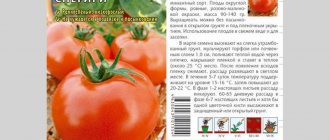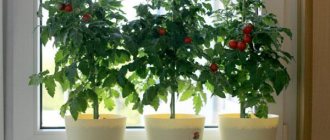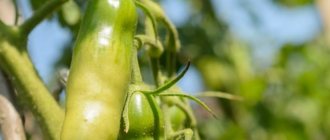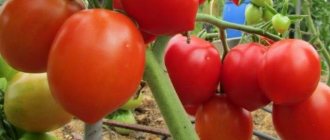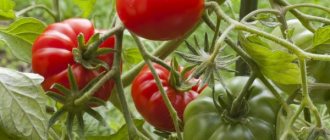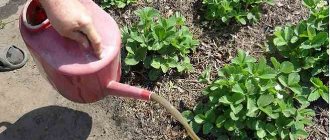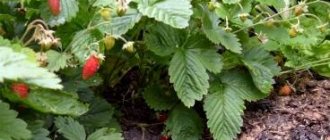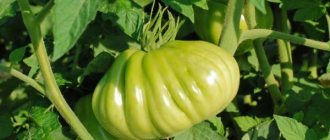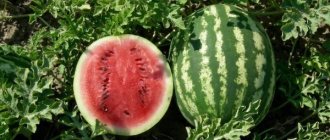Breeders create new tomato varieties and hybrids every year. Their fruits come in a variety of shapes, colors and sizes. On store shelves you can find tomatoes both the size of a small pumpkin and those resembling cherries in size. The latter are especially popular.
Small-fruited cherry tomatoes often have a richer taste and composition than their regular-sized counterparts. Therefore, they are appreciated by adherents of proper nutrition and connoisseurs of delicious salads and main courses. Gardeners willingly grow such tomatoes on their plots. The Sweet cherry tomato is also popular. It produces miniature berries with great flavor while being easy to grow. What are the disadvantages of this hybrid and is it worth your attention - read on.
Description of Sweet cherry tomato
Sweet cherry is a first generation tomato hybrid . This is indicated by the mark F1. You cannot use seeds obtained from your own harvest of this tomato. They will grow into plants with parental characteristics.
This is interesting! In the original, the name of the hybrid sounds like Sweet cherry, which means “candy cherry.” The tomato received this name for its unusual fruits, which resemble multi-colored candies the size of a large cherry.
The Sweet cherry tomato is not included in the Russian register . Despite this, many tomato seed manufacturers have been producing it for a long time.
Features of the hybrid
Sweet cherry has an unusual appearance . Its bushes are covered with colorful berries. The fruits of this hybrid come in orange, yellow and red shades.
This is interesting! This hybrid is also called the Candy Tree. Its bushes grow up to 2 meters. They form clusters with 30-50 fruits.
An uncharacteristic feature for cherry tomatoes is the early ripening of Sweet cherry. The berries of this hybrid ripen already at the end of June.
Main characteristics
Even a novice gardener can cope with growing Sweet cherry tomatoes . It has good immunity and ease of care. This tomato also has negative characteristics.
Description of Sweet cherry tomatoes:
| Parameter | Indicators |
| Bush type | Indeterminate hybrid. The height without limiting the growth point reaches 2 m. The stems are strong and powerful. The bushes form a large number of stepsons. The leaves are medium sized, dark green, simple, without pubescence. The first inflorescence is formed in the axil of 8-9 leaves, the rest - after 2-3 leaves. The fruits are collected in clusters, 20-50 pieces on each. Up to 6 brushes grow on one bush. |
| Growing method | The hybrid is not resistant to temperature changes and cold snaps. In the northern and central regions it is cultivated only in greenhouses. In the southern part of the country, cultivation in open ground is possible. This tomato is also grown on the balcony. |
| Productivity | Average. The maximum yield from 1 bush is 2.5 kg. From 1 sq. m harvest up to 7 kg of fruit. |
| Fruit | Small cherry tomatoes. The weight of one berry varies between 10-20 g. The berries are multi-colored. Yellow, orange and red fruits grow on one bush. The color of the shell matches the color of the pulp. Tomatoes are round in shape. There is no ribbing or flattening at the base. The taste is sweet, with barely noticeable sourness. The concentration of dry substances and sugars is close to 12%. The pulp is dense but juicy. The skin is glossy and shiny. Inside each berry there are 2 chambers with a small number of seeds. |
| Transportability | High. The fruits have a thick skin. It allows them to be transported over long distances and stored for a long time. |
| Ripening time | Early ripening hybrid. The berries ripen 80-90 days after the first shoots appear. Fruiting continues until frost. |
| Disease resistance | Has immunity to major tomato diseases. Even late blight does not affect it. |
Sweet Cherry
Description of the variety
Fruit:
- Ball-shaped, even shape;
- Different color palette: deep red, yellow or orange;
- With tender but dense pulp, pleasant, sweetish taste;
- Dry matter content about 12%;
- Sugar content up to 12%;
- Small sizes. Average weight is from 20 to 30 grams.
Bushes:
- Indeterminate type, not standard;
- When grown in greenhouse conditions, they reach a height of up to two meters or more.
Agricultural technology
Sweet cherry tomatoes are planted in a permanent place in early May . In the southern regions it is possible to plant in open ground, and in the central and northern regions - in a greenhouse.
When growing tomatoes on the balcony and windowsill, use 3 liter containers. In this case, the plants are sent to a permanent place 2 months after sowing the seeds.
3 days before planting in a permanent place, the seedlings are watered and fed. This helps the plants tolerate picking more easily.
Planting seedlings in a permanent place
For tomatoes choose a well-lit place . If the site has soil with a high clay content, tomatoes are planted on a hill.
In autumn, the selected area of the garden is cleared of remnants of weeds and cultivated plants . For 1 sq. m add 1 bucket of humus, 1 tbsp. l. ammonium nitrate, 2 tbsp. l. potassium nitrate and 2 tbsp. l. superphosphate. Dry lime is used to reduce soil acidity.
In the spring, the beds are dug up and cleared of plant roots. Chicken manure is used to enrich the soil. Many gardeners also add crushed eggshells to the soil. It is believed that it protects plants from mole crickets.
The holes are dug in rows in a checkerboard pattern . The distance between rows should be 60-70 cm, and between plants - 50-60 cm. Per 1 sq. m fits 3 plants.
A handful of ash or long-acting granular fertilizers are poured into each hole . Plants are placed in depressions, forming roots towards the center. The holes are covered with earth. 1 liter of water is poured onto each plant.
Cherry tomato preparations:
The most delicious recipes for pickling cherry tomatoes
How to make delicious pickled cherry tomatoes
Basic rules of care
The indeterminate hybrid Sweet cherry needs to be tied up . For these purposes, wooden supports or plastic trellises are used. The thread used to tie the bush as it grows should be synthetic.
Sweet cherry bushes are formed into 1-2 stems . The more stems left, the more abundant the harvest will be, but the later it will ripen.
When pinching plants, not only unnecessary stepsons are removed, but also the lower leaves. No more than 3 leaves are cut at a time. All withered greenery is also removed. The procedure is carried out no more than once a week on cloudy days.
Water tomatoes 1-2 times a week . The first time after transplanting the seedlings to a permanent place, the soil is moistened after 14 days.
Fertilizing is applied 3-4 times per season . The first time tomatoes are fertilized 2 weeks after picking. The second – in another 14 days. For the first 2 dressings, an infusion of plant residues and ammonium nitrate is used.
The rest of the fertilizing is applied with a break of 2 weeks . For them, drugs are used that include potassium and phosphorus. A solution of boric acid is used as foliar feeding. Plants are sprayed with it on cloudy days.
Advice from experienced gardeners
To avoid difficulties when growing tomatoes, you need to know some nuances. The list contains several useful gardening tips :
- When watering tomatoes, it is important that water does not get on the greenery of the plants. Therefore, the liquid is poured directly under the root. Gardeners who regularly grow tomatoes install a drip irrigation system.
- Before applying fertilizing, tomato beds are watered abundantly. This will prevent burns on the roots.
- After the fruits appear on the clusters , the tomatoes are watered more often, but use less water. This helps avoid cracking of the fruit.
- To speed up the formation of fruits , tomato bushes with inflorescences are shaken regularly.
- Tomatoes are planted and watered early in the morning or at sunset. It is convenient to carry out formation on cloudy days.
Diseases and pests
Sweet cherry tomato is immune to most tomato diseases . It is rarely affected by late blight, despite the fact that fruiting of this hybrid continues until the end of summer.
To reduce the likelihood of plant infection, you need to follow the basic rules of prevention:
- Disinfect not only seeds and containers for growing seedlings, but also garden tools with which the plants will interact. Tomato beds also need disinfection.
- Weed tomatoes regularly . Weeds contribute to the development of diseases and pest damage to plants.
- It is important not to violate the watering rules . The soil should not dry out, but the plants should not be flooded either.
- Plants need to be protected from pests . To do this, tomatoes are sprayed with a soap solution or a decoction of celandine. Large beetles are collected by hand.
Rules for care and cultivation
Cherry tomatoes are grown from seedlings. The timing of sowing seeds is calculated according to a simple scheme. 60 days are subtracted from the expected date of transplantation into the ground. For example, you are planning to plant tomatoes in a polycarbonate greenhouse. In your climate this is possible on April 20th. This means that the seeds can be sown on February 20th.
To sow seeds prepare:
- The plastic box is low.
- The purchased soil is fertile, consisting of garden soil, humus and two types of peat.
- For picking seedlings, use peat or plastic cups.
- Any liquid fertilizer for seedlings.
- Fluorescent lamp for illuminating plants.
Advice. Cherry bushes with red, yellow, orange fruits will decorate a greenhouse or vegetable garden. Buy seeds of different colored varieties.
Sow seeds in moist soil. Sprinkle 1 cm of humus or loose soil. Cover the box with the planted seeds with film or place it in a regular bag. The optimal room temperature is 25 °C.
To obtain strong seedlings:
- dive in the 2-leaf phase;
- water at least once a week;
- highlight tomatoes in cloudy weather;
- feed at least once 2 weeks before transplanting into the ground.
Features of cultivating a hybrid in the garden and at home
When growing tomatoes in a greenhouse, you need to take into account that the infection spreads faster indoors. To maintain humidity and reduce the likelihood of plant infection, greenhouses are regularly ventilated. In a greenhouse, plants form a larger number of stepsons. It is necessary to form tomatoes more often in such conditions.
In open ground, tomatoes need protection from night frosts, so they are covered with film in the evening. When it gets cold, the film is also used during the daytime.
At home , as well as in heated greenhouses, Sweet cherries are grown all year round. In this case, the structure is regularly ventilated. The lack of light is compensated with fluorescent lamps. It is important to consider that the hybrid reaches a height of 2 m. When growing at home, you will have to limit the growth point earlier.
Diseases and pests
The hybrid tomato "Sweet Cherry" is not afraid of diseases and insect pests. However, prevention is still recommended:
- To prevent blackleg, it is recommended to use only warm water for watering. Moisture should not stagnate in the soil. Also, the temperature regime is maintained within a range of at least +20 degrees;
- The appearance of slugs can be avoided by frequent ventilation of greenhouses and periodic spraying of bushes with biological products. As soon as fruit ovaries are formed, the use of insecticidal preparations is not recommended;
- The tomato hybrid “Sweet Cherry” is practically not susceptible to viral diseases, however, when grown in greenhouse conditions, the plant can be affected by gray or white rot. Non-toxic drugs are used as preventive measures. They spray and water the soil.
Harvesting and application
The first Sweet cherry harvest is harvested at the end of June . Tomatoes are picked either individually or in whole clusters.
At the end of summer, you need to realistically assess whether all the fruits will have time to ripen . It is better to remove excess ovaries - this way the formed berries will ripen faster.
The hybrid is universal in gastronomic terms , good in salads, pizzas and other dishes. Sweet cherry berries do not crack even when marinated as a whole. Their concentrated flavor makes them suitable for drying. The dense flesh allows them to be frozen whole.
Farmer reviews
Reviews about the Sweet Cherry hybrid are contradictory . Some gardeners are not satisfied with its low yield.
Irina, Yekaterinburg: “I have been growing Sweet cherry tomatoes for several years in an unheated greenhouse. I form it into 2 brushes. Productivity is average. There are cherry tomatoes with higher performance. I plant several Sweet bushes only because of their early ripeness. Already in June, tomatoes with excellent taste are on the table.”
Kirill, Klin: “I grow sweet cherries at home. There is no greenhouse at the dacha, so this variety is not suitable for our conditions. In winter, I additionally use fluorescent lamps. From 1 bush I collect up to 1 kg of berries. The taste of tomatoes is excellent. Good in salads and hot dishes. In addition, multi-colored beads on the bushes always decorate the apartment.”
Features of growing small-fruited tomatoes
To obtain a guaranteed harvest, the vegetable grower needs to pay attention to the following points:
- Pre-sowing preparation of seeds, which consists of disinfecting seeds in a weak solution of potassium permarganate and treating them with growth stimulants.
- Preparing land and containers for growing seedlings.
It is advisable to prepare soil for seedlings that is light and breathable. To do this, use ordinary garden soil with the addition of compost, ash, and mineral fertilizers. If the soil is clayey, peat or sand is added to it.
If necessary, the prepared soil is disinfected - heated in the oven or kept in the cold for several days.
When growing seedlings for a greenhouse, sowing usually begins in early March. Seeds are sown in moist soil at a distance of 1-2 cm from each other and covered with a layer of earth (approximately 5 mm). After this, comfortable conditions for germination are created: the boxes are covered on top with paper or film and the room temperature is maintained at 24-26 degrees.
Seedlings for planting in open ground are usually planted 2-3 weeks later.
After the first true leaf appears, the seedlings are planted in seedling cups or another box with a large volume of soil in which the plants can be planted at a distance of 15-20 cm.
